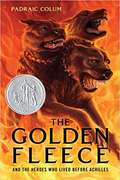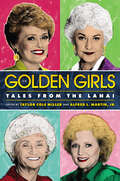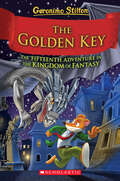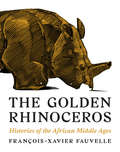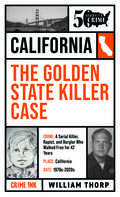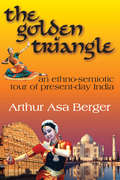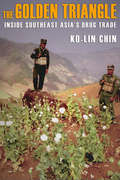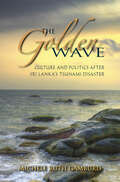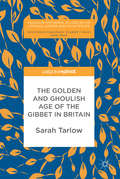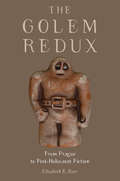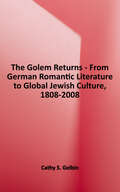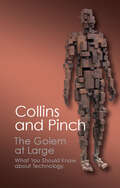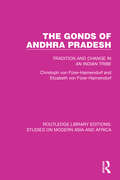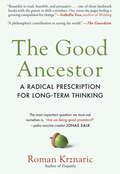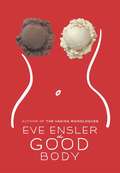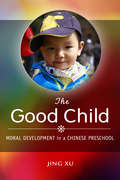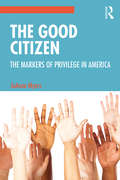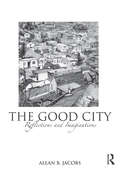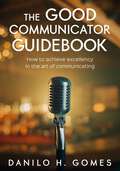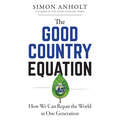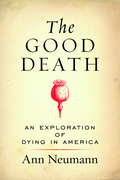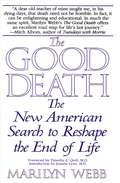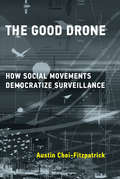- Table View
- List View
The Golden Fleece and the Heroes Who Lived Before Achilles
by Padraic ColumEnter a world where harpies torment mortals, the Argonaut Orpheus sings, the mighty god Zeus wages war on the Titans, and Prometheus steals fire. <P><P> Author Padraic Colum weaves the tales of Jason and his Argonauts with classic Greek mythology to create this captivating epic about life, war, and astounding beings who lived in a time long past. Poetically written and wonderful for reading aloud, this collection of ancient stories will captivate modern readers.<P> Newbery Honor book
The Golden Girls: Tales from the Lanai
by Ken Feil Ben Aslinger Peter C. Kunze Alfred L. Martin Jr. Kate Fortmueller Taylor Cole Miller Jessica Hoover Andrew Owens Claire Sewell Beth L Boser Jared Clayton Brown Ashleé Clark Eleanor Patterson Jr.The Golden Girls: Tales from the Lanai is an accessible collection that explores the cultural, industrial, and historical impact of that beloved American sitcom. Edited by Taylor Cole Miller and Alfred L. Martin, Jr., this anthology brings together a diverse range of voices that model different media studies approaches to researching and critically analyzing television texts. The Golden Girls reclaims the production history and development of the show, opens new conversations about audiences–especially Black, queer, and female audiences–and provides new insight into the meteoric rise in popularity of The Golden Girls as a 2020s cultural phenomenon. With twelve original chapters and extensive original interviews offering readers rare insights behind the scenes, the book is a long day’s journey into the marinara of The Golden Girls–an immersive, engaging opportunity for readers to learn more about the show. It truly is the golden age of The Golden Girls.
The Golden Key (Geronimo Stilton and the Kingdom of Fantasy)
by Geronimo StiltonGeronimo’s fifteenth adventure in the Kingdom of Fantasy!I, Geronimo Stilton, had been called to the Kingdom of Fantasy many times before.I’d visited the magical lands to ride dragons, meet fairies, and defeat evil witches. But not this time!This time, the Kingdom of Fantasy came to New Mouse City. Could I help Queen Imaginaria and put everyone back where they belong?
The Golden Rhinoceros: Histories of the African Middle Ages
by François-Xavier FauvelleA leading historian reconstructs the forgotten history of medieval AfricaFrom the birth of Islam in the seventh century to the voyages of European exploration in the fifteenth, Africa was at the center of a vibrant exchange of goods and ideas. It was an African golden age in which places like Ghana, Nubia, and Zimbabwe became the crossroads of civilizations, and where African royals, thinkers, and artists played celebrated roles in the globalized world of the Middle Ages. The Golden Rhinoceros brings this unsung era marvelously to life, taking readers from the Sahara and the Nile River Valley to the Ethiopian highlands and southern Africa.Drawing on fragmented written sources as well as his many years of experience as an archaeologist, François-Xavier Fauvelle painstakingly reconstructs an African past that is too often denied its place in history—but no longer. He looks at ruined cities found in the mangrove, exquisite pieces of art, rare artifacts like the golden rhinoceros of Mapungubwe, ancient maps, and accounts left by geographers and travelers—remarkable discoveries that shed critical light on political and architectural achievements, trade, religious beliefs, diplomatic episodes, and individual lives.A book that finally recognizes Africa’s important role in the Middle Ages, The Golden Rhinoceros also provides a window into the historian’s craft. Fauvelle carefully pieces together the written and archaeological evidence to tell an unforgettable story that is at once sensitive to Africa’s rich social diversity and alert to the trajectories that connected Africa with the wider Muslim and Christian worlds.
The Golden Road: Notes on my Gentrification
by Caille MillnerThe story of a remarkable young woman's struggle to find a home in the world, a place where she can define herself on her own terms, and live a life that matters.
The Golden State Killer Case (50 States of Crime)
by William ThorpCalifornia. 13 murders, 50 assaults, 42 years of investigation. In 2018, police announced that they had finally arrested the “Golden State Killer,” a man responsible for over 140 burglaries, 50 rapes and at least 13 murders committed in California throughout the 1970s and ’80s. That man turned out to be a former California police officer, Joseph James DeAngelo Jr. Just two months earlier, the publication of I’ll Be Gone in the Dark by Michelle McNamara had rocked the world of true crime. Published two years after her death, the book charts McNamara’s obsessive search for the prolific criminal who had been known over the years as the East Area Rapist, the Original Night Stalker, and the Visalia Ransacker, among other epithets. McNamara is credited with coining the “Golden State Killer” moniker and heightening public awareness of the—at the time—still unsolved case. William Thorp dives into the investigation, exploring the dark side of sunny California, the advances in forensic innovation that made solving this case possible, and the story inside the story—one of an amateur sleuth who dedicated the last years of her life to understanding how one of the country’s worst criminals could have spent so many decades undetected. 50 States of Crime: France’s leading true crime journalists investigate America’s most notorious cases, one for every state in the Union, offering up fresh perspectives on famously storied crimes and reflecting, in the process, a dark national legacy that leads from coast to coast.
The Golden Triangle: An Ethno-semiotic Tour of Present-day India
by Arthur Asa BergerThis book offers a semiotically informed ethnographic study of contemporary culture in Rajasthan and India. It adapts the methodology of analyzing cultures found in Roland Barthes' semiotic portrait of Japanese culture, "Empire of Signs", but adds an analysis of lifestyles as explicated in the work of social anthropologist Mary Douglas, political scientist Aaron Wildavsky, and a number of other social scientists. This manuscript is, at first, a guide to Rajasthan and India, and it is that but it is also more in that it considers tourism from both an anthropological and sociological level.Berger begins with statistics on tourism and other aspects of life in Rajasthan and India, and then considers how tourism in India compares with tourism in other important tourism destinations. He refers to the "Imaginary India" as the picture created in tourists' minds with the help of guidebooks, media, and the Internet before they actually travel to India. He then discusses these representations and how they are actually different from the country itself. The trip itself then becomes the search for the authentic India - the goal is to find places before they are discovered. He calls this "Semiotic Rajasthan," where the representations are compared to actuality.After offering a discussion of semiotic theory, it interprets and analyzes a number of important aspects of Rajasthani and Indian culture such as: the Taj Mahal, the Palace of Winds in Jaipur, the notorious rat temple in Deshnok, and sacred cows. Lastly, he discusses his own trip and how the impact of Rajasthan did not fully register until he returned home.This manuscript's strength lies in the author's ability to write in an accessible manner, assemble the project in an interesting way, and include only that information which will guide the reader along the narrative trail. While this manuscript really is a guidebook to Rajasthan, it could also serve as a good introduction to ethnography for beginning students and an interested general audience. It moves from basic explanations, such as that of semiotics, to complex applications all with the grace of good story telling.
The Golden Triangle: Inside Southeast Asia's Drug Trade
by Ko-Lin ChinThe Golden Triangle region that joins Burma, Thailand, and Laos is one of the global centers of opiate and methamphetamine production. Opportunistic Chinese businessmen and leaders of various armed groups are largely responsible for the manufacture of these drugs. The region is defined by the apparently conflicting parallel strands of criminality and efforts at state building, a tension embodied by a group of individuals who are simultaneously local political leaders, drug entrepreneurs, and members of heavily armed militias. Ko-lin Chin, a Chinese American criminologist who was born and raised in Burma, conducted five hundred face-to-face interviews with poppy growers, drug dealers, drug users, armed group leaders, law-enforcement authorities, and other key informants in Burma, Thailand, and China. The Golden Triangle provides a lively portrait of a region in constant transition, a place where political development is intimately linked to the vagaries of the global market in illicit drugs. Chin explains the nature of opium growing, heroin and methamphetamine production, drug sales, and drug use. He also shows how government officials who live in these areas view themselves not as drug kingpins, but as people who are carrying the responsibility for local economic development on their shoulders.
The Golden Wave: Culture and Politics after Sri Lanka's Tsunami Disaster
by Michele Ruth GamburdIn December 2004 the Indian Ocean tsunami devastated coastal regions of Sri Lanka. Six months later, Michele Ruth Gamburd returned to the village where she had been conducting research for many years and began collecting residents' stories of the disaster and its aftermath: the chaos and loss of the flood itself; the sense of community and leveling of social distinctions as people worked together to recover and regroup; and the local and national politics of foreign aid as the country began to rebuild. In The Golden Wave, Gamburd describes how the catastrophe changed social identities, economic dynamics, and political structures.
The Golden and Ghoulish Age of the Gibbet in Britain (Palgrave Historical Studies in the Criminal Corpse and its Afterlife)
by Sarah TarlowThis book is open access under a CC BY 4.0 licence. This book is the first academic study of the post-mortem practice of gibbeting (‘hanging in chains’), since the nineteenth century. Gibbeting involved placing the executed body of a malefactor in an iron cage and suspending it from a tall post. A body might remain in the gibbet for many decades, while it gradually fell to pieces. Hanging in chains was a very different sort of post-mortem punishment from anatomical dissection, although the two were equal alternatives in the eyes of the law. Where dissection obliterated and de-individualised the body, hanging in chains made it monumental and rooted it in the landscape, adding to personal notoriety. Focusing particularly on the period 1752-1832, this book provides a summary of the historical evidence, the factual history of gibbetting which explores the locations of gibbets, the material technologies involved in hanging in chains, and the actual process from erection to eventual collapse. It also considers the meanings, effects and legacy of this gruesome practice.
The Golem Redux: From Prague to Post-Holocaust Fiction
by Elizabeth R. BaerTraces the history of the golem legend and its appropriations in German texts and film as well as in post-Holocaust Jewish-American fiction, comics, graphic novels, and television.
The Golem Returns: From German Romantic Literature to Global Jewish Culture, 1808-2008
by Cathy S. GelbinThe Hulk, Superman, and the Terminator; are all modern popular culture echoes of the golem, that mystical, artificial man of legend, a sort of friendly Jewish version of Frankenstein's monster. By focusing on the golem in key literary texts and films, The Golem Returns explores the role that popular culture has played in the formation of modern Jewish culture. Widely seen as an icon of authentically Jewish lore, the golem has inspired a broad range of writers across ethnic, cultural, and national affiliations in Europe, the United States, and Israel. Previous scholarly accounts of the golem have sought to distinguish between a supposedly authentic Jewish folktale tradition on the golem and its modern literary rewriting. In contrast, The Golem Returns contends that the popular culture theme of the Golem as it is known today is the product of the complex cultural interaction between Jews and non-Jews since the early modern period, a process subverting stable and ethnically fixed notions of Jewish culture. Tracing the popular culture constructions of the golem by non-Jewish and Jewish writers since the early 1800s, Cathy S. Gelbin argues that golem representations have come full circle and that popular culture, despite its subversion of clearly demarcated ethnic origins, has played an important role in the construction of modern Jewish culture. The Golem Returns will be of interest to scholars of German and Jewish Studies, as well as readers examining popular culture, film, and the illustrated novel.
The Golem at Large
by Harry Collins Trevor PinchIn the very successful and widely discussed first volume in the Golem series, The Golem: What You Should Know About Science, Harry Collins and Trevor Pinch likened science to the Golem, a creature from Jewish mythology, a powerful creature which, while not evil, can be dangerous because it is clumsy. In this second volume, the authors now consider the Golem of technology. In a series of case studies they demonstrate that the imperfections in technology are related to the uncertainties in science described in the first volume. The case studies cover the role of the Patriot anti-missile missile in the Gulf War, the Challenger space shuttle explosion, tests of nuclear fuel flasks and of anti-misting kerosene as a fuel for airplanes, economic modeling, the question of the origins of oil, analysis of the Chernobyl nuclear disaster, and the contribution of lay expertise to the analysis of treatments for AIDS.
The Gonds of Andhra Pradesh: Tradition and Change in an Indian Tribe (Studies on Modern Asia and Africa)
by Christoph von Fürer-Haimendorf Elizabeth von Fürer-HaimendorfAmong the tribal populations of India there is none which rivals in numerical strength and historical importance the group of tribes known as Gonds. In the late 1970s, numbering well over four million, Gonds extend over a large part of the Deccan and constitute a prominent element in the complex ethnic pattern of the zone where Dravidian and Indo-Aryan populations overlap and dovetail. In the highlands of the former Hyderabad State (now Andhra Pradesh) concentrations of Gonds persisted in their traditional lifestyle until the middle of the twentieth century: feudal chiefs continued to function as tribal heads and hereditary bards preserved a wealth of myths and epic tales. It was at that time that Christoph von Fürer-Haimendorf first began his study of this group of Gonds, spending the better part of three years in their villages. While observing their daily life and their elaborate ritual performances, he also saw the threat which more advanced Hindu populations, infiltrating into the Gonds’ habitat and competing for their ancestral land, were posing to their way of life. During the thirty years prior to publication the author had frequently revisited the Gond region and in 1976-7 he undertook a detailed re-study of social and economic developments in the villages he knew best. His long-standing familiarity with many individual Gonds has allowed him to draw in this book, originally published in 1979, an intimate picture of the life of a specific village community and to trace the fates of individual men and women over a long stretch of time. While his earlier book The Raj Gonds of Adilabad: Myth and Ritual concentrated mainly on the Gonds’ mythology and ritual practices, the present volume devotes more space to a detailed analysis of the operation of social forces and the traditional structure of a society characterised by a high degree of cohesion. In 1979 the Gonds were once again being subjected to the pressure of outside forces and Professor von Fürer-Haimendorf lays special emphasis on the analysis of the process of social change forced upon the Gonds by settlers from outside. The last part of the book thus represents a case history of the transformation of a tribal society under the impact of modernisation and relentless population growth.
The Good Ancestor: A Radical Prescription For Long-term Thinking
by Roman KrznaricFrom leading philosopher Roman Krznaric, an urgent call to save ourselves and our planet by getting to the root of the current crisis—society’s extreme short-sightedness As heard on NPR’s TED Radio Hour When Jonas Salk developed the polio vaccine, he refused to patent it—forgoing profit so that more lives could be saved. His radical generosity to future generations should inspire us, but leading philosopher Roman Krznaric sees the opposite happening: Our short-term, exploitative mindsets have “colonized the future,” leaving an inexcusable chasm between the haves and have-nots—and mounting existential threats—that have brought our species to the precipice of disaster. Yet Krznaric sees reason to hope. The urgent struggle for intergenerational justice calls for hugely ambitious solutions, from rewiring our growth-at-all-costs economy to giving voters of future generations a voice in our democracies. But at the heart of all these changes is one we can enact within ourselves: We must trade shortsightedness for long-term thinking. In The Good Ancestor, Krznaric reveals six practical ways we can retrain our brains to think of the long view and to shift our allegiance from this generation to all humanity—to save our planet and our future.
The Good Body
by Eve EnslerBotox, bulimia, breast implants, stomach tucks - Eve Ensler is back, with another round of poignant and hilarious stories about the secret lives of women. Here are our intimate obsessions laid bare - who hasn't hungered for shapelier thighs, a nip or tuck or just a little piercing? Ensler toured the world asking women about their anatomical obsessions and gives us their stories: a Puerto Rican's ruminations on fat and family, an Indian beauty's obsession with hair, an LA woman's ultimate concession to h...
The Good Child: Moral Development in a Chinese Preschool
by Jing XuChinese academic traditions take zuo ren—self-fulfillment in terms of moral cultivation—as the ultimate goal of education. To many in contemporary China, however, the nation seems gripped by moral decay, the result of rapid and profound social change over the course of the twentieth century. Placing Chinese children, alternately seen as China's greatest hope and derided as self-centered "little emperors," at the center of her analysis, Jing Xu investigates the effects of these transformations on the moral development of the nation's youngest generation.The Good Child examines preschool-aged children in Shanghai, tracing how Chinese socialization beliefs and methods influence their construction of a moral world. Delving into the growing pains of an increasingly competitive and changing educational environment, Xu documents the confusion, struggles, and anxieties of today's parents, educators, and grandparents, as well as the striking creativity of their children in shaping their own moral practices. Her innovative blend of anthropology and psychology reveals the interplay of their dialogues and debates, illuminating how young children's nascent moral dispositions are selected, expressed or repressed, and modulated in daily experiences.
The Good Citizen: The Markers of Privilege in America
by JoAnne MyersUsing applied political theory, JoAnne Myers presents five markers by which citizens become second-class citizens—property, productivity, participation, patriotism, and reproduction. Citizenship is a highly contested status since it grants members political rights and responsibilities. It is contextualized by cultural, political, historical, economic, situational, and place. In the United States, we think of citizenship in principle as democratic, but citizenship is not just a binary status: norms, policies, and laws can mark some citizens as “other.” In The Good Citizen: The Markers of Privilege in America, Myers argues that being marked as not having or achieving these markers is how citizenship is controlled and regulated. To illustrate this argument, each chapter begins with a practical question or myth to ease the reader into the marker being examined. She later articulates the ways in which law and norms and biopower regulates and controls citizens in three policy areas. Myers moves beyond theories of citizen marginalization based on identity politics and intersectionality to provide a new understanding of citizenship practice. The Good Citizen will be of interest to scholars and researchers of politics, sociology, or legal studies of citizenship, and anyone concerned with distributive justice.
The Good City: Reflections and Imaginations
by Allan B. JacobsCities, Allan B. Jacobs contends, ought to be magnificent, beautiful places to live. They should be places where people can be fulfilled, where they can be what they can be, where there is freedom, love, ideas, excitement, quiet and joy. Cities ought to be the ultimate manifestation of society’s collective achievements. Allan B. Jacobs is one of the world’s best known planners and urban design practitioners, with a long and distinguished international career. Drawing on his professional experience of almost sixty years, Jacobs guides the reader through the lessons he’s learnt as a planner and lover of cities. Cities from Brazil, Italy, India, Japan, China and the US are featured. Written with a wonderfully engaging, humorous tone and Jacobs’ own drawings, The Good City transfers lessons on city design, building and urban change to all those willing to help cities become the magnificent, beautiful places they should be - and encourages all inhabitants to learn to appreciate and explore their own cities.
The Good Communicator Guidebook: How to achieve excellency in the art of communicating
by Danilo H. GomesA book that aims to instruct those who want to improve their communication techniques. The good communicator manual Do not know how to communicate well? Want to improve your ability to persuade and your verbal skills? Find what you need in this work. The human race is the only one of the other creatures present on planet Earth that is able to communicate through verbal language. Even though it is a skill present in humans, most of them have great difficulty in expressing themselves satisfactorily. The power of words is immeasurable, especially if used correctly. Speed, gestures, breathing, assembling sentences, everything counts when it comes to communication. A good communicator achieves high goals using only his or her language-related abilities. This book will help you evolve effectively in your verbal and non-verbal communication powers. By acquiring this work, you will have access to subjects such as: - Self analysis - Persuasion - How to use words correctly - Identification of common communication errors - Objectivity and effectiveness through speaking "How to Improve Vocabulary" - Communication in the relationship - Techniques to improve non-verbal communication - Communication in appearance And much more! Transform your way of communicating and achieve your goals more easily!
The Good Country Equation: How We Can Repair the World in One Generation
by Simon AnholtWhy doesn't the world work? Why, despite all the power, technology, money and knowledge that humanity has accumulated, are we are still unable to defeat global challenges like climate change, war, poverty, migration, extremism, and inequality? Simon Anholt has spent decades helping countries from Austria to Zambia to improve their international standing. Using colorful descriptions of his experiences--dining with Vladimir Putin at his country home, taking a group of Felipe Calderon's advisors on their first Mexico City subway ride, touring a beautiful new government hospital in Afghanistan that nobody would use because it was in Taliban-controlled territory--he tells how he began finding answers to that question. Ultimately, Anholt hit on the Good Country Equation, a formula for encouraging international cooperation and reinventing education for a globalized era. Anholt even offers a "selfish" argument for cooperation: he shows that it generates goodwill, which in turn translates into increased trade, foreign investment, tourism, talent attraction, and even domestic electoral success. Anholt insists we can change the way countries behave and the way people are educated in a single generation--because that's all the time we have.
The Good Death
by Ann NeumannFollowing the death of her father, journalist and hospice volunteer Ann Neumann sets out to examine what it means to die well in the United States.When Ann Neumann's father was diagnosed with non-Hodgkin's lymphoma, she left her job and moved back to her hometown of Lancaster, Pennsylvania. She became his full-time caregiver--cooking, cleaning, and administering medications. When her father died, she was undone by the experience, by grief and the visceral quality of dying. Neumann struggled to put her life back in order and found herself haunted by a question: Was her father's death a good death?The way we talk about dying and the way we actually die are two very different things, she discovered, and many of us are shielded from what death actually looks like. To gain a better understanding, Neumann became a hospice volunteer and set out to discover what a good death is today. She attended conferences, academic lectures, and grief sessions in church basements. She went to Montana to talk with the attorney who successfully argued for the legalization of aid in dying, and to Scranton, Pennsylvania, to listen to "pro-life" groups who believe the removal of feeding tubes from some patients is tantamount to murder. Above all, she listened to the stories of those who were close to death.What Neumann found is that death in contemporary America is much more complicated than we think. Medical technologies and increased life expectancies have changed the very definition of medical death. And although death is our common fate, it is also a divisive issue that we all experience differently. What constitutes a good death is unique to each of us, depending on our age, race, economic status, culture, and beliefs. What's more, differing concepts of choice, autonomy, and consent make death a contested landscape, governed by social, medical, legal, and religious systems.In these pages, Neumann brings us intimate portraits of the nurses, patients, bishops, bioethicists, and activists who are shaping the way we die. The Good Death presents a fearless examination of how we approach death, and how those of us close to dying loved ones live in death's wake.From the Hardcover edition.
The Good Death: The New American Search to Reshape the End of Life
by Marilyn WebbThe Good Death is the first full-scale examination of one of today's most complex issues: the profound change in the way Americans think about and confront death. Drawing on more than six years of firsthand research and reporting, noted journalist Marilyn Webb builds her account around intimate portraits of the dying themselves. She explains why some deaths become shockingly difficult--and needlessly painful--and how the struggles over end-of-life decisions can pit patient and family against hospitals, doctors, insurance companies, religious groups, and the law.But there is good news as well. Webb describes many extraordinary programs and individuals who are changing the face of dying. An abundant source of comfort and hope, The Good Death shows how the essential elements of humane--even uplifted--death are available to all of us, if we know what is possible, where to go for help, and how to prepare.From the Trade Paperback edition.
The Good Doctors: The Medical Committee for Human Rights and the Struggle for Social Justice in Health Care
by John DittmerIn the summer of 1964 medical professionals, mostly white and northern, organized the Medical Committee for Human Rights (MCHR) to provide care and support for civil rights activists organizing black voters in Mississippi. They left their lives and lucrative private practices to march beside and tend the wounds of demonstrators from Freedom Summer, the March on Selma, and the Chicago Democratic Convention of 1968. Galvanized and sometimes radicalized by their firsthand view of disenfranchised communities, the MCHR soon expanded its mission to encompass a range of causes from poverty to the war in Vietnam. They later took on the whole of the United States healthcare system. MCHR doctors soon realized fighting segregation would mean not just caring for white volunteers, but also exposing and correcting shocking inequalities in segregated health care. They pioneered community health plans and brought medical care to underserved or unserved areas. Though education was the most famous battleground for integration, the appalling injustice of segregated health care levelled equally devastating consequences. Award-winning historian John Dittmer, author of the classic civil rights history Local People: The Struggle for Civil Rights in Mississippi, has written an insightful and moving account of a group of idealists who put their careers in the service of the motto “Health Care Is a Human Right.”
The Good Drone: How Social Movements Democratize Surveillance (Acting with Technology)
by Austin Choi-FitzpatrickHow small-scale drones, satellites, kites, and balloons are used by social movements for the greater good.Drones are famous for doing bad things: weaponized, they implement remote-control war; used for surveillance, they threaten civil liberties and violate privacy. In The Good Drone, Austin Choi-Fitzpatrick examines a different range of uses: the deployment of drones for the greater good. Choi-Fitzpatrick analyzes the way small-scale drones--as well as satellites, kites, and balloons--are used for a great many things, including documenting human rights abuses, estimating demonstration crowd size, supporting anti-poaching advocacy, and advancing climate change research. In fact, he finds, small drones are used disproportionately for good; nonviolent prosocial uses predominate.
